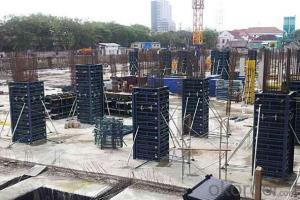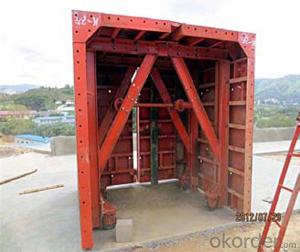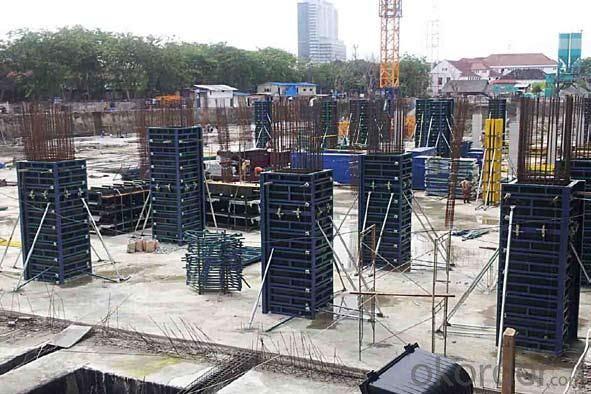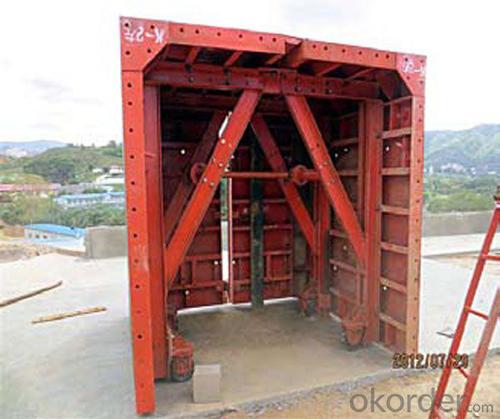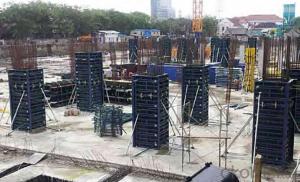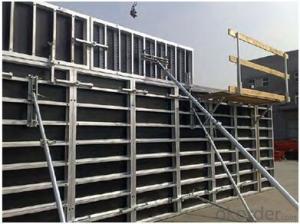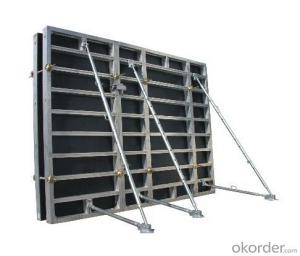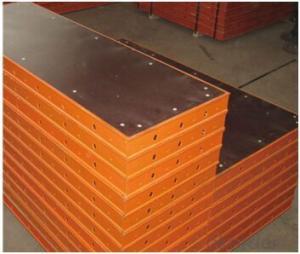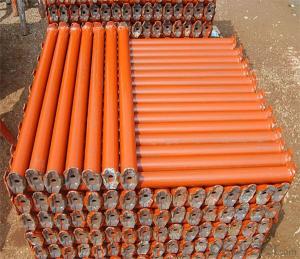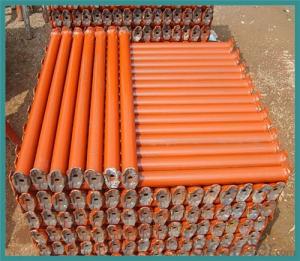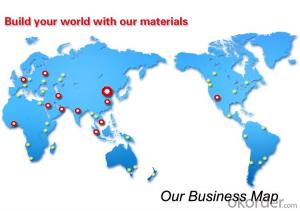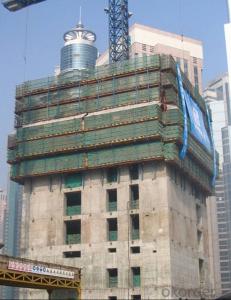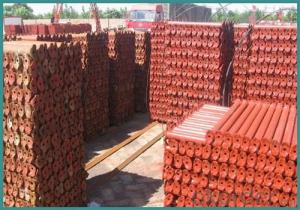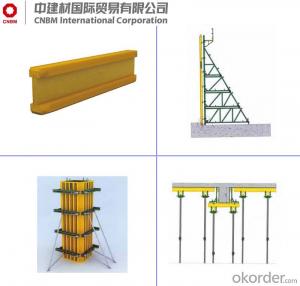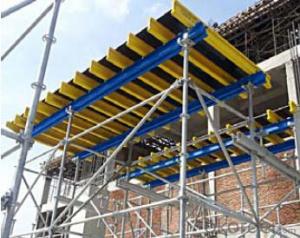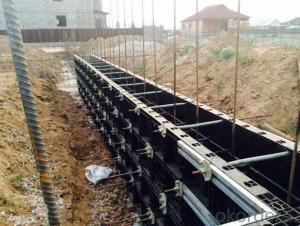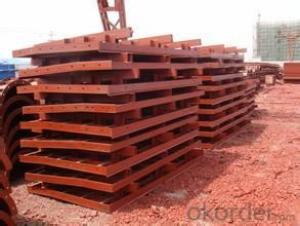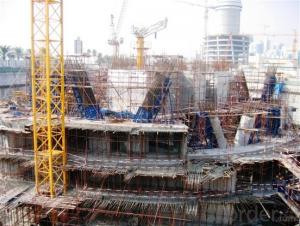Steel Formwork Scaffolding System Formwork System low price
- Loading Port:
- Tianjin
- Payment Terms:
- TT OR LC
- Min Order Qty:
- 20 m.t
- Supply Capability:
- 1000 m.t/month
OKorder Service Pledge
OKorder Financial Service
You Might Also Like
Steel Formwork Scaffolding System Formwork System with low price
Product pictures:
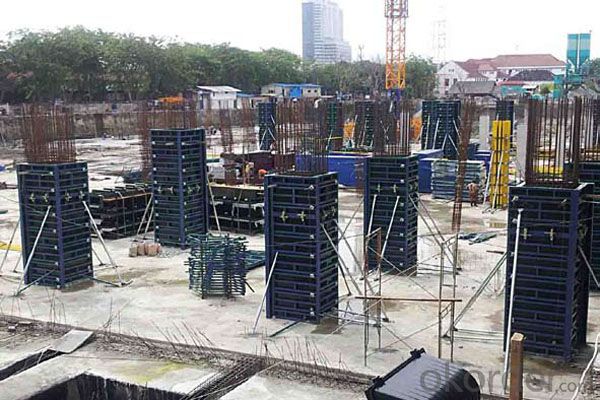

Product description:
Name: | RingLock Scaffold System |
Category: | Scaffolding System |
Material: | Steel (Q235/Q345) |
Size: | D48*3.25mm, etc |
Surface: | Electro Galvanized, Hot Dipped Galvanized, Painted, Powder Coated |
Component: | Standard, Ledger, Diagonal Brace, Bracket, Base Jack, U Head Jack, Etc. |
Application: | Slab Support, Staircase, Stage Plateforms, Bridge Support, Mobile Tower, etc. |
Manufacturer: | OEM is Available |
Items or goods can be manufactured according to your standards. | |
Advantage
* Good loading capacity
* Easy to assemble and dismantle
* Excellent quality for formwork & scaffolding with wide choices
Other scaffolding & formwork products:
(1) Scaffolding System:
(2) Scaffolding Frame & Accessories:
(3) Scaffolding Couplers/Clamps:
(4) Formwork System Scaffolding & Accessories:
Company introduce and advantages:
1. A state-owned company, prestige fi rst.
2. One of Fortune 500 companies in the world. No. 5 in the building material fi eld.
3. Six Sigma strategy , which means no more than 3.4 defects existing among one million of error
possibilities.
4. In line with the business, we launched E-business platform Okorder.com.
FAQ
Why Us?
We are one of the largest construction materials suppliers in China.
We own professional manufacturers with powerful producing capacity.
Efficient services in pre and after sale.
Full energy with affluent experience team.
- Q: How does steel frame formwork handle the placement of landscaping and outdoor features within the concrete structure?
- A versatile and efficient system for constructing concrete structures, steel frame formwork offers numerous advantages when incorporating landscaping and outdoor features. By providing a strong and stable support system, it easily accommodates the placement of various elements. The flexibility of steel frame formwork is a key advantage when shaping the concrete structure. Customizable and adjustable, the steel frames allow for the creation of different shapes and designs, ensuring precise integration of landscaping and outdoor features. Whether it's curved or irregular shapes, steps or terraces, retaining walls or decorative elements, the steel frame formwork can handle it all. Furthermore, the steel frame formwork offers a secure and sturdy platform for the placement of landscaping and outdoor features. It reinforces and supports the concrete structure, allowing for the safe installation of elements such as planters, fountains, seating areas, pathways, and even swimming pools or outdoor kitchens. This seamless integration creates a cohesive and visually appealing design. Efficient construction processes are also facilitated by steel frame formwork. The system is designed for easy assembly and disassembly, enabling quick and precise adjustments as required by the landscaping and outdoor features. This saves time and labor during construction and allows for future modifications or additions to the outdoor elements. Overall, steel frame formwork is an ideal solution for incorporating landscaping and outdoor features within a concrete structure. Its flexibility, strength, and efficiency make it a reliable choice for harmoniously integrating the built environment with the natural surroundings.
- Q: What are the different types of formwork hinges used with steel frame formwork systems?
- There are two main types of formwork hinges used with steel frame formwork systems: fixed hinges and adjustable hinges. Fixed hinges are used when the desired formwork angle does not need to be changed, providing a stable and rigid connection between formwork panels. On the other hand, adjustable hinges allow for flexibility in adjusting the formwork angle, making them suitable for projects with varying concrete structures. These hinges offer ease of use and versatility in formwork installation and removal.
- Q: Can steel frame formwork be used for both straight and curved slab construction?
- Absolutely, steel frame formwork is suitable for both straight and curved slab construction. This adaptable system grants the freedom to fashion various shapes and designs for concrete slabs. The steel frames can be easily modified and tailored to meet the specific demands of the project, regardless of whether it involves a straight or curved slab. Consequently, this renders it suitable for an extensive array of construction undertakings, ranging from uncomplicated straight slabs to intricate curved structures. Moreover, the robustness and longevity of steel guarantee a dependable choice for formwork, safeguarding the slabs' form and structural soundness throughout the construction journey.
- Q: How does steel frame formwork prevent the formation of concrete cracking during curing?
- Steel frame formwork prevents the formation of concrete cracking during curing by providing a strong and rigid support structure that holds the concrete in place and prevents it from shifting or settling. This ensures that the concrete maintains its intended shape and structural integrity throughout the curing process, minimizing the risk of cracks forming due to uneven curing or excessive stress.
- Q: Can steel frame formwork be used for educational buildings?
- Yes, steel frame formwork can be used for educational buildings. It provides a sturdy and durable structure, ensuring the safety and longevity of the building. Additionally, steel frame formwork allows for flexibility in design and construction, accommodating various architectural and educational requirements.
- Q: Steel frame wood fire doors are graded? Grade A, B, C?
- The material of the product is consistent with the test report; 5, the product performance parameters are consistent with the test report. Three, the product performance test items and the unqualified description of 1 fire door code MFM 1021 B L S K (1.2h) 5 armour a wooden fire door B (0.9h) the code c (0.6h) fireresistance grade hole width code 5 clockwise to close the entrance code 6 counterclockwise direction switch under the direction of code box D single s double cutting cutting cutting code with bright window doors with glass 2 inspection items and unqualified inspection items required description unqualified appearance should be complete without damage, the net surface appearance is not complete, damaged, surface net light, light, no dig burr and hammer India; cutting angle, planer marks, burr and hammer India; cutting angle, lax seam welds should be tight formation; real smooth appearance; in place should be provided in the provisions of the product marks, No product marks, quality inspection quality inspection marks and quality certification (certification mark and quality certification (accreditation) qualified mark) mark. Annals. Size regulation should not exceed the shape description of sample size lattice dimensions should describe the shape of sample size size thickness should be more than the door door fan in the door leaf thick description of sample thickness
- Q: Can steel frame formwork be used for both straight and sloped structures?
- Yes, steel frame formwork can be used for both straight and sloped structures. Steel frame formwork is a versatile system that can be easily adjusted to accommodate different angles and slopes. It provides a stable and sturdy support for concrete pouring, ensuring accurate and precise construction of both straight and sloped structures. The steel frame can be easily assembled and disassembled, allowing for flexibility and adaptability in construction projects with varying requirements. Overall, steel frame formwork is an effective solution for constructing both straight and sloped structures.
- Q: How does steel frame formwork compare to plastic formwork?
- The specific requirements of the construction project determine whether steel frame formwork or plastic formwork is the better choice. Steel frame formwork is known for its durability and strength, making it suitable for projects requiring repeated use. It can handle heavy loads, is reusable, and can be easily customized. It also provides stability and support for precise concrete placement. On the other hand, plastic formwork has its own advantages. It is lightweight and easy to handle, making it ideal for projects that need frequent transportation and assembly. It resists corrosion, reducing maintenance costs over time. Additionally, it offers good insulation properties. However, plastic formwork may not be as effective as steel frame formwork in handling heavy loads or lasting as long. It may also have limitations in terms of customization and adjustability for complex shapes. In conclusion, the choice between steel frame formwork and plastic formwork depends on factors such as project requirements, budget, and specific conditions. Steel frame formwork is reliable and versatile, while plastic formwork is lightweight and cost-effective. It is important to consider project needs and consult with construction professionals to determine the most suitable formwork option.
- Q: How does steel frame formwork contribute to the overall energy efficiency of a concrete structure?
- Steel frame formwork contributes to the overall energy efficiency of a concrete structure in several ways. Firstly, steel frame formwork provides a strong and durable support system, allowing for the construction of larger and more complex concrete structures. This means that fewer materials are required, reducing energy consumption during construction. Additionally, steel frame formwork facilitates faster construction times and allows for easier reusability. This reduces the need for additional energy-intensive construction processes, such as the production of new formwork for each project. Furthermore, steel frame formwork offers excellent thermal conductivity, which can help regulate the temperature within the concrete structure. This can reduce the need for excessive heating or cooling, resulting in lower energy consumption and improved overall energy efficiency. Overall, the use of steel frame formwork in concrete structures promotes sustainability by minimizing material waste, reducing construction time, and optimizing energy consumption throughout the building's lifespan.
- Q: Are there any limitations to using steel frame formwork in certain weather conditions?
- Yes, there are limitations to using steel frame formwork in certain weather conditions. Steel frame formwork is generally durable and can withstand adverse weather conditions such as rain, wind, and moderate temperatures. However, extreme weather conditions such as heavy rainstorms, freezing temperatures, or high winds can pose challenges to using steel frame formwork. In heavy rainstorms, water can accumulate on the steel frame formwork, making it slippery and unsafe for workers. It can also affect the concrete curing process, leading to potential structural issues. In freezing temperatures, the metal frames can become brittle, increasing the risk of cracks or structural failure. Additionally, cold weather can slow down the concrete curing process, which can affect the overall construction timeline. High winds can also pose a risk to steel frame formwork, especially if the construction site is located in an area prone to hurricanes or strong gusts. The strong winds can exert significant pressure on the formwork, potentially causing it to collapse or become unstable. This can not only lead to safety hazards but also result in delays and additional costs for repairs or replacements. To mitigate these limitations, it is essential to consider weather conditions when selecting formwork systems. In regions with extreme weather, alternative formwork systems such as insulated formwork or plastic formwork may be more suitable. It is also crucial to ensure proper maintenance and inspection of steel frame formwork to identify any potential weaknesses or structural issues that may arise due to weather conditions. Overall, while steel frame formwork is generally robust, it is necessary to assess the specific weather conditions and potential limitations before deciding to use it in construction projects.
Send your message to us
Steel Formwork Scaffolding System Formwork System low price
- Loading Port:
- Tianjin
- Payment Terms:
- TT OR LC
- Min Order Qty:
- 20 m.t
- Supply Capability:
- 1000 m.t/month
OKorder Service Pledge
OKorder Financial Service
Similar products
Hot products
Hot Searches
Related keywords
